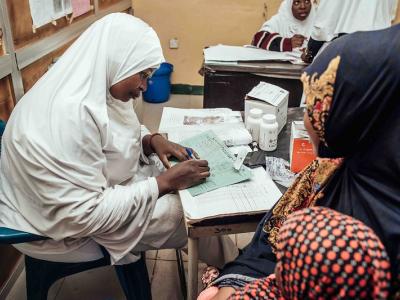Study: CTX-M-27 gene emerging in clinical E coli isolates in Germany
German researchers have found a significant increase in strains of Escherichia coli carrying a gene linked to extended-spectrum beta-lactamase (ESBL) production, according to a study yesterday in Emerging Infectious Diseases.
The researchers analyzed a representative subset of 953 sequenced isolates from ESBL-producing E coliisolates collected from livestock, humans, companion animals, food, and the environment during 2009 to 2016. They were specifically looking for the CTX-M-27 allele in E coli sequence type (ST) 131, which has emerged globally as a prevalent vehicle for ESBL. While ESBL production in certain clades of E coliST131 associated with urinary tract infections and bacteremia is generally conferred by the CTX-M-15 allele, recent reports from Japan and France have documented an increase of C1-M27 clade isolates.
Multilocus sequence typing identified 159 (17%) of the 953 isolates as ST131. The most prevalent ESBL genes in the ST131 isolates were CTX-M-15 (73[46%]), CTX-M-27 (24[15%]), CTX-M-1 (18[11%]), and CTX-M-14 (15[9%]). CTX-M-27 was present exclusively in clinical isolates, and its incidence increased from 0% in 2009 to 45% in 2016, with 19 of the 24 isolates obtained in 2015 and 2016.
"The data suggest an ongoing shift in CTX-M alleles associated with ST131 infections worldwide that now warrants further attention," the authors write.
Aug 31 Emerg Infect Dis research letter
Study: Respiratory viral testing has small effect on antibiotics for pneumonia
Originally published by CIDRAP News Aug 31
Molecular respiratory viral testing had minimal impact on reducing antibiotic utilization among viral pneumonia patients, according to a study yesterday in the American Journal of Infection Control.
In the multisite cohort study of 190 patients diagnosed with community-associated pneumonia (CAP), researchers compared the clinical characteristics and antibiotic therapy of patients who tested positive on a polymerase chain reaction respiratory viral panel (PCR-RVP) with those who tested negative. PCR-RVP can detect multiple viral pathogens and gives physicians the ability to make a specific diagnosis of viral pneumonia, which in theory should lead to reduced antibiotic use.
Of the 190 patients diagnosed with CAP, 108 (57%) were RVP positive for viral pathogens and 82 (43%) were RVP negative. Clinical outcomes between the two groups were similar. But while RVP-positive patients were less likely to be continued on antibiotic therapy for longer than 48 hours compared to RVP-negative patients (72% vs. 90%), the median duration of antibiotic treatment in the two groups was not significantly different (3 days vs. 4 days).
"Our study suggests that physicians hesitate to discontinue antibiotic therapy even when patients are found to have viral pneumonia using a highly sensitive and specific PCR methodology," the authors of the study write, adding that potential coinfection with bacterial pathogens is a common clinical challenge.
They suggest combining PCR-RVP testing with testing for procalcitonin (PCT), a biomarker that can help differentiate between bacterial and viral pneumonia, could help reassure physicians that patients with viral pneumonia do not have a bacterial superinfection, and help them identify which patients may be candidates for discontinuing antibiotic therapy.
Aug 30 Am J Infect Control abstract
Turkish data reveal high level of Staphylococcus antiseptic resistance genes
Originally published by CIDRAP News Aug 31
Researchers in Turkey report a high frequency of antiseptic resistance genes in clinical staphylococci samples in a study yesterday in Antimicrobial Resistance and Infection Control.
In the study, 69 Staphylococcus spp. (including methicillin-resistant S aureus, methicillin-susceptible S aureus, methicillin-resistant coagulase-negative staphylococci, and methicillin-susceptible coagulase-negative staphylococci) and 69 Enterococcus spp. were collected from various clinical samples at a university hospital from January 2010 to March 2011. Researchers then conducted antiseptic and antibiotic susceptibility tests and analyzed antiseptic resistance genes using the polymerase chain reaction method. It has previously been reported that antiseptic resistance genes caused tolerance to a variety of biocidal agents used to prevent infections in hospitals.
Overall, antiseptic resistance genes were found in 49 of the 69 staphylococci isolates, and none of the enterococci isolates. Among the 49 staphylococci isolates positive for an antiseptic resistance gene, qacA/B genes were the most dominant (28/49), followed by qacJ (18/49), qacG (16/49), and smr (11/49) genes. The frequency of qacA/B and smr genes was higher in coagulase-negative staphylococci (CNS) when compared with S aureus isolates, while the frequency of qacG and qacJ genes was higher in S aureus than those of CNS.
The researchers also found a statistically significant association between the presence of antiseptic resistance genes and the minimum inhibitory concentration of benzalkonium chloride (BAC), a biocidal agent commonly used in hospitals. But no significant relationship was found between the presence of antiseptic resistance genes and antibiotic resistance.
"Further studies are needed to revise the biocide policy and to support infection control programs to avoid the development of new resistance mechanisms," the authors write.
Aug 31 Antimicrob Resist Infect Control study
Rare, resistant bacteria linked to chronic ear infections in Angola
Originally published by CIDRAP News Aug 28
Researchers have discovered that more than 10% of patients with chronic ear infections at an ear, nose, and throat clinic in Angola were co-colonized with a fluoroquinolone-resistant bacterium commonly found in bird feces.
In a new study in Emerging Infectious Diseases, the researchers report that analyses of samples from 188 patients at a clinic in Luanda, Angola, who had ear discharge related to chronic suppurative otitis media (CSOM), found that 20 patients (10.6%) were colonized by the gram-negative bacillus Alcaligenes faecalis, which was resistant to both ciprofloxacin and levofloxacin. Pseudomonas aeruginosa was the predominant species in 50% of those patients, and Proteus mirabilis the second most common.
Although the presence of A faecalis was originally a mystery, the researchers learned that, to prevent ear discharge from CSOM, a common condition in many developing countries, patients occasionally filled their external auditory canals with dove or pigeon feces. The authors note that it remains to be confirmed whether A faecalis plays a crucial role for disease progression or is merely a contaminant. CSOM is generally caused by P aeruginosa and P mirabilis.
Because the A faecalis isolates were resistant to fluoroquinolones, they authors suggest an alternative strategy of colistin as topical treatment or supplement with orally administered amoxicillin/clavulanic acid for treatment of more severe cases.
Aug 25 Emerg Infect Dis research letter
Study finds short-duration antibiotics superior for intra-abdominal infection
Originally published by CIDRAP News Aug 28
Findings from a new analysis that uses novel methods of evaluating data from antibiotic trials suggest that a short duration of antibiotic therapy is superior to a longer duration of therapy for patients with complicated intra-abdominal infections.
In a study today in Clinical Infectious Diseases, a team of researchers retrospectively applied desirability of outcome ranking (DOOR) and response adjusted for duration of antibiotic risk analyses (RADAR) to data from the Trial of Short-Course Antimicrobial Therapy for Intra-abdominal Infection (STOP-IT), a multisite, randomized controlled trial that evaluated short-duration antibiotic therapy for treating abdominal infections after initial source control. While the initial trial concluded that short, fixed-duration therapy (approximately 4 days) is non-inferior to traditional, longer-duration therapy (approximately 8 days), the researchers theorized that using the DOOR/RADAR approach—which categorizes patients into a list of potential clinical outcomes and ranks them by the desirability of the associated outcome and duration of therapy—could provide stronger conclusions.
Using the DOOR analysis, all 518 STOP-IT patients were categorized as having one of five mutually exclusive outcomes: (1) recovery, with no complications; (2) recovery, with extra-abdominal infection (including Clostridium difficile); (3) recovery with surgical site/wound infection; (4) recovery with recurrent intra-abdominal infection requiring procedure; or (5) death. Then RADAR was applied to DOOR results to further stratify patients with similar outcomes.
Analysis based on this five-tiered scoring system showed that the probability that randomly selected patients would have a better DOOR score if receiving short-course antibiotics was 49.33%. The probability that randomly selected patients undergoing traditional-duration therapy would have a better DOOR score was 50.6%. Application of RADAR showed that the probability that randomly selected patients would have a better DOOR score if receiving short-course therapy was 63.4%. In addition, analysis of a smaller sample size of patients (150) using DOOR/RADAR showed that the probability of an improved DOOR score was 66.3% for patients in the short-course group.
The authors conclude, "In summary, DOOR/RADAR analysis can be used in antibiotic trials to globally evaluate for superiority of new antibiotic strategies that previously might have been reportable only as noninferior."
Aug 28 Clin Infect Dis study












